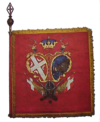

Sima Marković (Veliki Borak, 1768 – Belgrade, 22 March 1817) was a Serbian voivode who led his men in the First Serbian Uprising.[1] He was one of four leaders of the Belgrade Nahiya along with Pavle Popović, Nikola Nikolajević, and Milisav Čamdžija.
Biography
Marković was a prominent statesman, member and president of the Governing State Council of Serbia (he became president on Assumption Day in 1805).[2][3] He was the Obor-knez of the Sanjak of Smederevo, also known as the Pashalik of Belgrade Nahiya in 1793. He was also a participant in Kočina Krajina. In the First Serbian Uprising, he led the army in Ivankovac, Mišar, Deligrad, in the liberation of Smederevo and Čokešina. The army of Prince Sima Marković was the first to enter the city of Belgrade on 13 December 1806, during the liberation of Belgrade from the Turks. He became the trustee of the People's Treasury, that is, the first Minister of Finance in 1811. With Dragić Gorunović and Pavle Cukić, he raised an uprising against Prince Miloš Obrenović and the Turks in 1817,[4] but the uprising was suppressed, and he was captured and executed by Marashli Ali Pasha at Kalemegdan, on the day of the Forty Martyrs of Sebaste (Mladence).[5][6][7]
Streets in Belgrade, Smederevo and Kragujevac and the street leading to his birthplace, as well as the elementary school in Barajevo, are named after him. "Days of Prince Sima Marković" have been organized in Veliki Borak for more than four decades, at the end of August.[8]
See also
References
- ^ Larousse, Pierre (1960). "Grand Larousse encyclopιdique - Pierre Larousse, Larousse (Firm) - Google Books". Retrieved 2020-06-08.
- ^ "Култура". barajevo.org.rs. Градска општина Барајево. Retrieved 25 November 2013.
- ^ "Барајево". tob.rs. Туристичка организација Београда. Archived from the original on 3 December 2013. Retrieved 25 November 2013.
- ^ "Études balkaniques - Google Books". 2008-07-02. Retrieved 2020-06-08.
- ^ Cirkovic, Sima M. (2008-04-15). The Serbs - Sima M. Cirkovic - Google Books. ISBN 9781405142915. Retrieved 2020-06-08.
- ^ Petrovich, Michael Boro (2010-02-26). A history of modern Serbia, 1804-1918 - Michael Boro Petrovich - Google Books. ISBN 9780151409501. Retrieved 2020-06-08.
- ^ "Југославија - Google Books". 2010-12-06. Retrieved 2020-06-08.
- ^ "Кнез Сима Марковић - први министар финансија". ckb.org.rs. Центар за културу Барајево. Archived from the original on 2 December 2013. Retrieved 25 November 2013.

